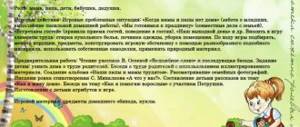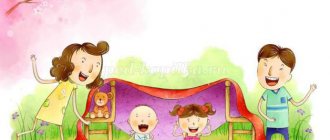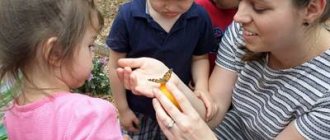The importance of role-playing games in a child’s life
Plot-role-playing game and its educational significance.
We all know that children, in their play, lose out on the lives of adults.
Many children's games imitate the serious activities of adults. (Ya. Korczak).
What is a role-playing game?
In order to understand what a role-playing game is, you need to delve into the scientific definition of the game.
GAME is an intrinsically valuable activity for a preschooler;
GAME is an optional activity not related to the achievement of utilitarian goals;
GAME – an activity that brings pleasure
A game is a type of unproductive activity, the motive of which lies not in its results, but in the process itself.
Game is one of the types of human activity. As a complex and interesting phenomenon, it attracts the attention of people of different professions.
Researchers note the value of the game, its conventionality, and also point to its importance in the formation of social behavior and human self-affirmation. on the possibility of predicting his behavior in a communication situation.
For children, play, which is commonly called a “childhood companion,” constitutes the main content of life, acts as a leading activity, and is closely intertwined with work and learning. All aspects of the personality are involved in the game: the child moves, speaks, perceives, thinks; During the game, all his mental processes are actively working: thinking, imagination, memory, emotional and volitional manifestations are intensified. The game acts as an important means of education.
Role-playing game.
Role-playing game is the main type of play for a preschool child.
It develops children's potential;
is crucial for the mental development of the child; is a form of modeling by the child of social relationships; has unique features, a unique structure, and specific features that distinguish it from other types of games.
What is its peculiarity?
Role-playing play is the most spontaneous manifestation of a child, and at the same time it is built on the interaction of the child with adults. It has the main features of the game: emotional richness and enthusiasm of children, independence, activity, creativity. The main source that feeds a child’s role-playing play is the world around him, the life and activities of adults and peers.
The main feature of a role-playing game is the presence of an imaginary situation in it. The imaginary situation consists of a plot and roles.
The plot of the game is a series of events that are united by vitally motivated connections. The plot reveals the content of the game - the nature of the actions and relationships between the participants in the events.
The role is the main core of the role-playing game. Most often, the child takes on the role of an adult. Having a role in the game means that in his mind the child identifies himself with this or that person and acts in the game on his behalf. The child uses certain objects appropriately (prepares dinner like a cook; gives an injection like a nurse), enters into various relationships with other players (praises or scolds his daughter, examines a patient. The role is expressed in actions, speech, facial expressions, pantomime.
In the plot, children use two types of actions: operational and figurative - “as if.”
Along with toys, various things are included in the game, and they are given an imaginary, playful meaning.
In a role-playing game, children enter into real organizational relationships (agree on the plot of the game, distribute roles, etc.). At the same time, complex role relationships are simultaneously established between them (for example, mother and daughter, captain and sailor, doctor and patient, etc.).
A distinctive feature of an imaginary play situation is that the child begins to act in a mental, rather than visible, situation: the action is determined by a thought, not a thing. However, the thought in the game still needs support, so often one thing is replaced by another (a stick replaces a spoon), which allows you to carry out the action required by meaning.
The most common motive for role-playing games is the child’s desire for a joint social life with adults. This desire collides, on the one hand, with the child’s unpreparedness for its implementation, and on the other, with the growing independence of children. This contradiction is resolved in a role-playing game: in it, a child, taking on the role of an adult, can reproduce his life, activities and relationships. The originality of the content of a role-playing game is also one of its most important features. Thus, play is an activity in which children themselves model the social life of adults.
Role-playing game in its developed form, as a rule, is of a collective nature. This doesn't mean children can't play alone. But the presence of children's society is the most favorable condition for the development of role-playing games. Preschool childhood is the most important period of personality development. During these years, the child acquires initial knowledge about the life around him, he begins to form a certain attitude towards people, towards work, develops skills and habits of correct behavior, and develops a character. The main activity of preschool children is play; it develops the child’s spiritual and physical strength; his attention, memory, imagination, discipline, dexterity. In addition, play is a unique way of learning social experience, characteristic of preschool age. In play, all aspects of a child’s personality are formed and developed; significant changes occur in his psyche, which prepare the transition to a new, higher stage of development.
Compliance with the rules
.
The rules regulate the actions of the child and the teacher and say that sometimes you have to do something that you don’t want to do. It’s difficult for adults to do something they don’t like, but for a child it’s hundreds of times more difficult. The ability to act according to the rule does not just appear in a child. An important stage of preschool development is role-playing play, where obedience to the rule follows from the very essence of the game.
By mastering the rules of role behavior in the game, the child also masters the moral norms contained in the role. Children master the motives and goals of the activities of adults, their attitude to their work, to events and phenomena of social life, to people, things: in the game a positive attitude is formed towards the way of life of people, towards the actions, norms and rules of behavior in society.
Social motive of games.
The social motive is laid down in the role-playing game. Play is an opportunity for a child to find himself in the world of adults, to understand the adult system himself. When play reaches its peak, it becomes insufficient for the child to replace relationships with play, as a result of which the motive to change his status matures. The only way he can do this is to go to school.
In the role-playing game there is emotional development
.
A child’s play is very rich in emotions, often ones that are not yet available to him in life. Many domestic psychologists asked the following questions: “Does the child experience feelings or just portray them? What influence do they have on the formation of the child’s moral character?” A. N. Leontyev believes that in the very depths of the genesis of the game, in its very origins, there are emotional foundations. The study of children's games confirms the correctness of this idea. The child distinguishes play from reality; the speech of preschoolers often contains the following words: “as if,” “make believe,” and “in truth.” But despite this, gaming experiences are always sincere. The child is not pretending: the mother truly loves her doll daughter, the driver is seriously concerned about whether he will be able to save his friend who was in an accident.
The outstanding Russian psychologist L. S. Vygotsky also noted that although the child creates imaginary situations during role-play, the feelings he experiences are very real. “Katya is a mother,” says the tiny girl, and, trying on a new role, she plunges into an imaginary world. And, regardless of whether her “daughter” was bought in an expensive toy store or sewn by a caring grandmother from Katya’s old tights, the little mother does not just repeat after her elders the manipulations that are supposed to be performed on babies, but experiences a real feeling of maternal love for her “ baby."
As the game and game design become more complex, children's feelings become more conscious and complex. When a child imitates the astronauts, he will convey his admiration for them and his dream of becoming the same. And at the same time, new feelings arise: responsibility for the assigned task, joy and pride when it is successfully completed. I.M. Sechenov gave a physiological justification for the importance of play for the formation of feelings; he proved that play experiences leave a deep imprint on the child’s consciousness. Repeated repetition of the actions of adults and imitation of their moral qualities influence the formation of the same qualities in the child.
From the above, we can conclude that role-playing game is a school of feelings, in which the child’s emotional world is formed.
During the course of role-playing games, the preschooler’s intellect develops.
The development of a plan in a role-playing game is associated with the general mental development of the child, with the formation of his interests. Preschool children develop an interest in various life events, in different types of adult work; they have favorite book characters whom they strive to imitate. As a result, the ideas of games become more persistent, sometimes taking over their imagination for a long time. Some games (in “sailors”, “pilots”, “cosmonauts”) continue for weeks, gradually developing. The emergence of a long-term perspective of the game speaks of a new, higher stage in the development of gaming creativity. In this case, there is no repetition of the same theme day after day, as happens with children, but a gradual development, enrichment of the planned plot. Thanks to this, children's thinking and imagination become purposeful. The child's prolonged stay in one role forces him to delve deeper into the meaning of what he portrays.
In role-playing games, imagination and creativity develop.
Planned, coordinated actions in long-term role-playing games are combined with improvisation. Children outline a general plan, a sequence of actions, and during the game new ideas and new images arise. So, during a multi-day “sea voyage”, first one or the other participant in the game came up with new interesting episodes: divers sank to the bottom of the sea and found treasures, in hot countries they caught lions and took them to the zoo, in Antarctica they fed polar bears. The development of gaming creativity is also reflected in how various life experiences are combined in the content of the game. Already at the end of the third and fourth years of children’s lives, one can observe that they combine different events in play, and sometimes they can include episodes from fairy tales that were shown to them in the puppet theater. For children of this age, vivid visual impressions are important. Later (in the fourth and fifth years of life), children incorporate new experiences into their old favorite games. Reflecting life in a game, repeating life impressions in different combinations - all this helps the formation of general ideas and makes it easier for the child to understand the connection between different phenomena of life.
To implement a plan in a role-playing game, a child needs toys and various objects that help him act in accordance with the role he has taken on. If the necessary toys are not at hand, then children replace one object with another, endowing it with imaginary characteristics. This ability to see non-existent qualities in an object is one of the characteristic features of childhood. The older and more developed children are, the more demanding they are about the objects of play, the more similarities they look for with reality.
Speech development.
The role of words is especially important in creating an image. The word helps the child to identify his thoughts and feelings, understand the experiences of his partners, and coordinate his actions with them. The development of purposefulness and the ability to combine is associated with the development of speech, with the ever-increasing ability to put one’s ideas into words. L. S. Vygotsky argued that the development of children's imagination is directly related to the acquisition of speech. Children delayed in their speech development are also retarded in the development of imagination.
There is a two-way connection between speech and play. On the one hand, speech develops and becomes more active in the game, and on the other hand, the game itself develops under the influence of speech development. The child uses words to designate his actions, and thereby comprehends them; He also uses words to complement actions and express his thoughts and feelings. In older preschool age, sometimes entire episodes of play are created using words. The role of the word is especially noticeable in the so-called director's games, where the child does not take on a role, as in a regular game, but moves dolls and other toys and speaks for them. There is an element of directing in every game with dolls. “Mom” speaks and acts both for herself and for her doll daughter.
Types of role-playing games:
1.Games based on everyday stories
: to “home”, “family”, “holidays”, “birthdays”. And these games are occupied by games with dolls, through actions with which children convey what they know about their peers, adults, and their relationships.
2. Games on industrial and social topics
, which reflects the work of people. For these games, themes are taken from the surrounding life (school, store, library, post office, hairdresser, hospital, transport (bus, train, plane, ship), police, firefighters, circus, theater, menagerie, plant, factory, mine, construction, collective farm, army).
3. Games on heroic and patriotic themes
, reflecting the heroic deeds of our people (war heroes, space flights, etc.).
4. Games on literary themes
, cinema, television and radio programs: in “sailors” and “pilots”, in the Hare and the Wolf, the crocodile Gena and Cheburashka (based on the content of the cartoons), in the four “tankers” and a dog (based on the content of the movie), etc. In these games the children reflect entire episodes from literary works, imitating the actions of the heroes, adopting their behavior.
5. "Director's" games
, in which the child forces the dolls to speak and perform various actions. At the same time, he acts on two levels - both for the doll and for himself, directing all actions. Participants in the game think through a scenario in advance, which can be based on episodes from familiar fairy tales, short stories, or their own lives. Children “teach” the puppets of the puppet and finger theaters, and the toy theater to “act” in accordance with the role they take on, endowing them with literary or imaginary characteristics.
Levels of development of role-playing games
First stage.
The main content of the game is actions with objects. They are carried out in a certain sequence, although this sequence is often disrupted. The chain of actions is plot-based. The main subjects are everyday ones. Children's actions are monotonous and often repeated. Roles are not defined. In form it is a side-by-side game or a single player game. Children willingly play with adults. Independent play is short-lived. As a rule, the stimulus for the emergence of a game is a toy or a substitute object that was previously used in the game.
Second phase
. The main content of the game is actions with an object. These actions unfold more fully and consistently in accordance with the role that is already denoted by the word. The sequence of actions becomes the rule. The first interaction between participants occurs based on the use of a common toy (or direction of action). Associations are short-lived. The main subjects are everyday ones. The same game can be repeated many times. Toys are not selected in advance, but children often use the same ones - their favorite ones. The game can already unite 2-3 people.
Third stage
. The main content of the game is also actions with objects. However, they are complemented by actions aimed at establishing various contacts with playing partners. Roles are clearly defined and assigned before the game begins. Toys and objects are selected (most often during the game) in accordance with the role. Logics; the nature of actions and their direction are determined by the role. This becomes the basic rule. The game often proceeds as a joint game, although interaction is interspersed with parallel actions of partners who are not related to each other and are not correlated with the role. The duration of the game increases. The plots become more diverse: children reflect everyday life, the work of adults and vibrant social phenomena.
Fourth stage.
The main content of the game is a reflection of the relationships and interactions of adults with each other. The themes of games can be varied: it is determined not only by the direct, but also by the indirect experience of children. Games are joint and collective in nature. Associations are stable. They are built either on children’s interest in the same games, or on the basis of personal sympathies and affections. Games of the same content are not only repeated for a long time, but also develop, become enriched, and exist for a long time. In the game at this stage, the preparatory work is clearly distinguished: the distribution of roles, the selection of game material, and sometimes its production (homemade toys). The requirement to comply with the logic of life applies not only to actions, but also to all actions and role behavior of the participants. Up to 5-6 people are involved in the game.
Thus, play is the main activity of preschool children, during which the child’s spiritual and physical strength develops.
Why is playing both important and useful?
The importance of play in a child’s life is difficult to overestimate. Educational fun organized and led by an adult is a real benefit. Here's what it consists of:
- the child develops his own opinion, his attitude towards events and people;
- he develops certain behavioral skills and habits;
- he gains insight into social norms;
- gets the opportunity to practice their communication skills;
- develops discipline, patience, cognitive sphere, expands his worldview;
- creative and speech skills develop;
- he actively learns to absorb information;
- gains invaluable social experience;
- In the process, older children can master counting, letters, develop logic, attention, and memory.
For older children
Role-playing classes for children aged 3 to 4 years are already more interesting and varied. At this age, babies have knowledge about this world. They are able to weave their experiences, stories from fairy tales and cartoons into the plot, and make it all part of the game.
At this age, it is important to give the child the opportunity to choose a role for himself - the one he likes.
Here are some examples of role-playing fun for this age:
- At the doctor. The game increases vocabulary, develops attention, sensitivity, and understanding of the functions of medical instruments. A child can be a doctor, toys can be his patients. Patients complain about their illness, the doctor listens to them, makes a diagnosis, and prescribes treatment. For this activity you will need a medical kit for children.
- Walk. The goal is to teach the child how to choose appropriate clothes. Development of fine motor skills. Also, remembering the names of items of clothing and shoes. The scenario is simple - the baby prepares the doll for going outside, chooses her shoes and clothes, naming all the items. Then he puts on the toy. The doll will need costumes and clothes for different seasons.
- Doll's birthday. The child learns to place dishes on the table and remembers the names of cutlery. Trains in skills of attention and caring. Also – expands your vocabulary. The plot is as follows: a child chooses a birthday girl doll. Then he prepares the festive table, arranges the cutlery, and sends toys to visit the birthday girl. You can come up with gifts.
- Shop. Goal: the child learns the names of goods, learns to plan purchases, and classify them. Expands your vocabulary. He develops a communicative culture. The preschooler chooses who to be - a seller or a buyer. Then, if he is a buyer, he plans his purchases, goes to the store, and politely communicates with the seller.
Video of a role-playing game for children: a trip to the zoo:
Role-playing games for children - playing doctor video




